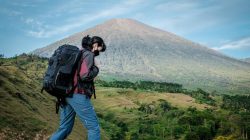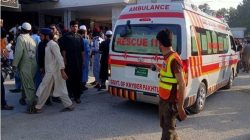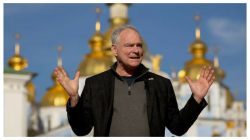On World Refugee Day, displaced Africans face the worst conditions yet as conflict and disasters increase, aid plummets and borders tighten.
The number of displaced Africans has doubled since 2018. For the 14th consecutive year, conflict and climate change have driven record numbers of people from their homes.
Changes in national priorities, economic uncertainty and donor fatigue have seen political attention turn inward, surges in defence spending and corresponding aid cuts, the shuttering of refugee resettlement programmes, and tighter border security. African refugees bear the brunt of these changes. Those already in dire situations now face even bigger threats to their survival.
Last week, the United Nations Refugee Agency (UNHCR) released its annual Global Trends
report
. At the end of 2024, 123.2 million people were displaced, up by seven million in one year. Most displaced Africans remain in their home countries or neighbouring countries, many of which are also resource-poor and suffer from conflict.
The number of internally displaced persons (IDPs) in Africa has
tripled
since 2015, reaching 35.4 million in 2024. Sudan and the Democratic Republic of the Congo (DRC) comprised almost half (45 per cent) of all conflict-driven internal displacements worldwide in 2024.
Sudan is the world’s
largest
displacement and humanitarian crisis. The civil war has driven 14.4 million people from their homes and left two-thirds of the population requiring humanitarian aid. Most (11.6 million) are internally displaced (see graph), and 2.8 million are across borders. At the end of 2024, conflict in eastern DRC had created 1.22 million refugees and asylum seekers, and 6.9 million IDPs.
As of April 2025, the UNHCR reported a 1 per cent drop in total refugees worldwide for the first time in a decade. In 2024, 1.6 million people returned to their home countries – mainly Syria, Afghanistan and Ukraine. Many returned to poor conditions after giving up trying to access rights and services in host countries.
South Sudan was the only African country to see significant returns. Going home is not viable for most refugees on the continent due to the protracted nature of conflicts. Many end up spending their lives in severely underfunded camps, unable to work, study or move freely. Funding cuts will worsen their prospects.
The Norwegian Refugee Council issues an annual list of the top 10 most
neglected
displacement crises globally. Eight in 2025 are in Africa: Cameroon, Ethiopia, Mozambique, Burkina Faso, Mali, Uganda, the DRC and Somalia.
The council rated Cameroon the world’s most neglected crisis, assigning a zero out of 30 rating for political will and ‘negligible’ media coverage. Cameroon hosts people fleeing internal conflicts and violence in the Lake Chad Basin and Central African Republic. It hosts 1.1 million IDPs, 480 000 refugees, and has 2.8 million people facing acute food security.
Most marginal gains in refugee resettlement numbers over the past three years were due to the United States (US). The country raised its resettlement ceiling to 125,000 refugees per year during former president Joe Biden’s last three years in office. Although it fell short of the ceiling each year, in 2024 the US
resettled
100,034 refugees, the highest number in three decades.
At the start of his second term, US President Donald Trump issued an
executive
order imposing a near-full halt on foreign aid and the Refugee Admissions Program, followed by a halt on activities supporting refugees. Reports also indicate Mr Trump is diverting $250 million from foreign
aid
budgets towards repatriating foreigners, often without due process and at times against court orders.
The US recently implemented a travel
ban
that disproportionately affects Africans, including full bans on people from Chad, Congo-Brazzaville, Equatorial Guinea, Eritrea, Libya, Somalia and Sudan, and partial bans on those from Burundi, Sierra Leone and Togo.
While the US has made the harshest changes, the United Kingdom
reduced
development assistance by 40 per cent, and several European countries announced their own reductions. The European Union (EU)
redirected
some of its development budget to Ukraine and border management. Historically, official development aid has always been dwarfed by military spending (see graph).
European countries and the EU are also
reorienting
their migration policies away from humanitarian support and legal pathways to increasing securitisation measures to reduce flows and pressuring governments to accept returns.
Under the Pact on Migration and Asylum, set to take effect in 2026, the European Commission will remove the requirement for a
connection
between a migrant and a ‘safe third country’. Migrants can then be sent to any country deemed ‘safe’ – even if they have no connection to that country. The pact also allows for rapid asylum processing for people from countries deemed safe, and for their detention.
Before the major slashes, global refugee funding gaps already reached $24 billion in 2024. Funding for humanitarian food aid is projected to
drop
by up to 45 per ent, and most forcibly displaced people are in areas experiencing food crises. The concomitant reductions in development aid will reduce host country governments’ fiscal capabilities to support refugees.
Remittances are the most resilient forms of aid and are pivotal to development. They comprise the largest financial flow to Africa and have proven countercyclical, meaning they often go up when markets go down or experience a shock. In another step ostensibly to counter irregular migration, a 3.5 per cent tax on remittances is included in the US’ One Big Beautiful
Bill
that would directly impact development in Africa if enacted.
The sum total of these conditions is catastrophic for African refugees and IDPs. Many people are exposed to harm, with fewer protections and almost no development prospects. Programmes such as education, psychosocial support and health care are cut first because they are not life-saving.
Many African countries that already resist or are outright hostile to refugees will be more likely to shut borders and demolish camps if they think the world is no longer paying attention or has set a double standard. In some circumstances, these conditions will drive onward migration and push people towards illegality.
Aimée-Noël Mbiyozo, Senior Research Consultant, Migration, Institute for Security Studies (ISS)
(This article was
first published
by ISS Today, a Premium Times syndication partner. We have their permission to republish).
Provided by SyndiGate Media Inc. (
Syndigate.info
).







